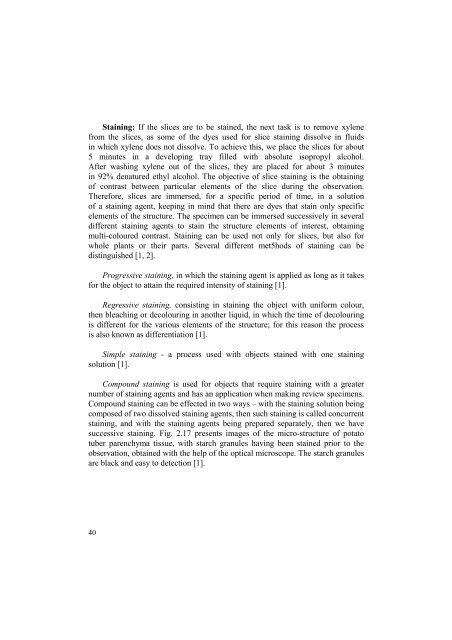MICRO-STRUCTURE ANALYSIS OF PLANT TISSUES - Lublin
MICRO-STRUCTURE ANALYSIS OF PLANT TISSUES - Lublin
MICRO-STRUCTURE ANALYSIS OF PLANT TISSUES - Lublin
You also want an ePaper? Increase the reach of your titles
YUMPU automatically turns print PDFs into web optimized ePapers that Google loves.
Staining: If the slices are to be stained, the next task is to remove xylene<br />
from the slices, as some of the dyes used for slice staining dissolve in fluids<br />
in which xylene does not dissolve. To achieve this, we place the slices for about<br />
5 minutes in a developing tray filled with absolute isopropyl alcohol.<br />
After washing xylene out of the slices, they are placed for about 3 minutes<br />
in 92% denatured ethyl alcohol. The objective of slice staining is the obtaining<br />
of contrast between particular elements of the slice during the observation.<br />
Therefore, slices are immersed, for a specific period of time, in a solution<br />
of a staining agent, keeping in mind that there are dyes that stain only specific<br />
elements of the structure. The specimen can be immersed successively in several<br />
different staining agents to stain the structure elements of interest, obtaining<br />
multi-coloured contrast. Staining can be used not only for slices, but also for<br />
whole plants or their parts. Several different met5hods of staining can be<br />
distinguished [1, 2].<br />
Progressive staining, in which the staining agent is applied as long as it takes<br />
for the object to attain the required intensity of staining [1].<br />
Regressive staining, consisting in staining the object with uniform colour,<br />
then bleaching or decolouring in another liquid, in which the time of decolouring<br />
is different for the various elements of the structure; for this reason the process<br />
is also known as differentiation [1].<br />
Simple staining - a process used with objects stained with one staining<br />
solution [1].<br />
Compound staining is used for objects that require staining with a greater<br />
number of staining agents and has an application when making review specimens.<br />
Compound staining can be effected in two ways – with the staining solution being<br />
composed of two dissolved staining agents, then such staining is called concurrent<br />
staining, and with the staining agents being prepared separately, then we have<br />
successive staining. Fig. 2.17 presents images of the micro-structure of potato<br />
tuber parenchyma tissue, with starch granules having been stained prior to the<br />
observation, obtained with the help of the optical microscope. The starch granules<br />
are black and easy to detection [1].<br />
40

















